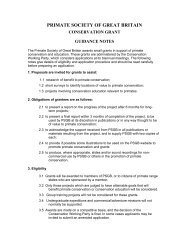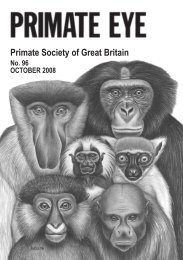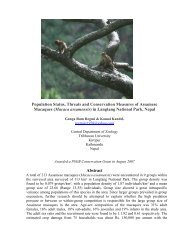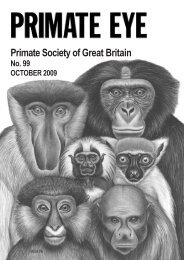2010 Vol 101.pdf (1.63mb) - Primate Society of Great Britain
2010 Vol 101.pdf (1.63mb) - Primate Society of Great Britain
2010 Vol 101.pdf (1.63mb) - Primate Society of Great Britain
You also want an ePaper? Increase the reach of your titles
YUMPU automatically turns print PDFs into web optimized ePapers that Google loves.
Part III discusses ecological diversity in gibbons, addressing important<br />
theoretical issues in primatology such as the relationships between body<br />
mass and diet quality, and niche overlap between gibbons and other<br />
sympatric species. This combines nicely with Part IV <strong>of</strong> the book, which<br />
explores factors influencing inter- and intraspecific variation in gibbon<br />
communities, and how this is a function <strong>of</strong> contextual ramifications such as<br />
social systems, defensibility, and habitat use.<br />
Part V presents a nice overview <strong>of</strong> the mating systems <strong>of</strong> hylobatids, and<br />
tentatively addresses particular evolutionary advantages <strong>of</strong> living in a<br />
monogamous society and the proximate means through which this structure<br />
is maintained. Following this synopsis, complimentary data are given on<br />
specific species, notably siamangs and white-handed gibbons, to highlight<br />
particular behavioural and hormonal aspects <strong>of</strong> gibbon societies. Female<br />
reproductive status is examined in relation to temporal fluctuation in genital<br />
swellings and hormone concentrations using data from captive and wild<br />
individuals. The authors also discuss differences between male and female<br />
gibbons living in polyandrous and monogamous groups, and how flexible<br />
grouping and mating, relatedness, infanticide risk, and social networks are<br />
causal factors for variation in allocation <strong>of</strong> parental care and degree <strong>of</strong><br />
monogamy.<br />
While socioecological data on primates is meaningful from a purely<br />
academic point <strong>of</strong> view, we must not forget the obligations researchers have<br />
towards the welfare and conservation <strong>of</strong> the species they study. Indeed,<br />
while gibbons are arguably the most successful species <strong>of</strong> non-human ape<br />
on the planet, some species are among the rarest and most critically<br />
endangered <strong>of</strong> any primate. In the final chapter <strong>of</strong> The Gibbons, several<br />
authors bring forth case studies on a few gibbon species to discuss<br />
important threats to gibbon populations in the wild, highlighting regions <strong>of</strong><br />
major impact, habitat requirements, and population trends. This section <strong>of</strong><br />
the book concludes with a discussion <strong>of</strong> the urgent need for further<br />
information on gibbon behaviour to refine protocols for conservation<br />
management, and provides recommendations for improving conservation<br />
success through rehabilitation programs and canopy bridges.<br />
The Gibbons represents an important progression towards better<br />
understanding small ape behaviour. This book should be treated as a wellrounded<br />
reference for scholars interested in learning more about small apes,<br />
or for anyone wishing to examine important topics in primatology from a<br />
small ape standpoint. Commonly labelled “the lesser ape” by non-partisans,<br />
this book celebrates the importance <strong>of</strong> such exceptional beings, warranting<br />
the small apes recognition far “greater” than what they typically are given<br />
within the scientific and public domain.<br />
F. Blake Morton<br />
Scottish <strong>Primate</strong> Research Group and University <strong>of</strong> Stirling<br />
51






